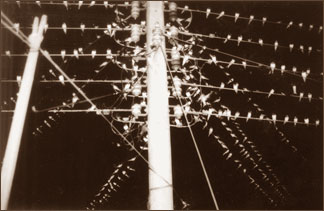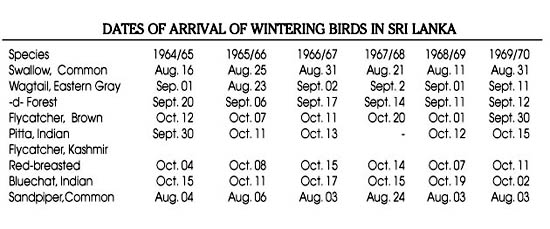Wintering birds return
by K. G. H. Munidasa
|

Common swallows roosting at night on powerline cables in
Avissawella. pic: K. G. H. Munidasa
|
Birds on migration, not only return to the same locality, year after
year, but often also to the identical site in their winter quarters. The
great regularity of the arrival of migrant birds in Sri Lanka or the
punctuality of their appearances, even to the day, in some places are
evident from the records maintained over the years by interested
observers, Residing in different parts of the country.
This is all the more astounding when the vast distances some of these
birds cover to reach our shores are taken into account. For example,
individuals of the Indian Pitta, Brown Shrike and the Brown Flycatcher,
believed to be the same birds, have returned to a particular home garden
in the Low Country Wet Zone, year after year, for five years running. In
the Kelani Valley that familiar winter visitor Common Swallow appears
each year in late August or September and departs the following April.
It is on record that the forerunners of the Kashmir Red-breasted
Flycatcher and the Indian Bluechat arrived in their customary winter
habitats in the Central Hill Zone regularly in the 2nd or 3rd week of
October each year. Meanwhile, the common Sandpiper appears in the
upcountry streams every year about the first week of August.
It has been found that scattered parties of the Forest Wagtails
started arriving in their regular roosting places in the Gal Oya Valley
from mid-September onwards, each year.
 A
forest wagtail, which was ringed and released by the Ceylon Bird Club at
a ringing camp at Muwangala (Ampara district) in 1963 returned to the
same roosting place next year and was caught in a mist net, once again.
Similarly, another picked up dead in 1966 was found to carry an
identification ring that had been attached to its leg in the previous
year at a ringing camp, half a mile from the spot. A female Bluechat,
which was ringed in 1964 at Deltota (Galaha) returned the following year
to the same restricted home garden, while an Eastern Gray Wagtail
returned two years later to the same place, where it was ringed and
released. (Please see tabulated box). A
forest wagtail, which was ringed and released by the Ceylon Bird Club at
a ringing camp at Muwangala (Ampara district) in 1963 returned to the
same roosting place next year and was caught in a mist net, once again.
Similarly, another picked up dead in 1966 was found to carry an
identification ring that had been attached to its leg in the previous
year at a ringing camp, half a mile from the spot. A female Bluechat,
which was ringed in 1964 at Deltota (Galaha) returned the following year
to the same restricted home garden, while an Eastern Gray Wagtail
returned two years later to the same place, where it was ringed and
released. (Please see tabulated box).
A Philippine Shrike, said to be a scarce North-East Monsoon visitor
from far-Eastern Asia, was noted in a tea estate close to Nuwara Eliya
(6,500 ft.) for several years in succession. Moreover, in the Winter of
1976/77 Ceylon Bird Club placed on record a male of the Himalayan
Orange-Headed Ground Thrush, yet another scarce visitor, as having
occupied a small plot of land at Dehiwala, South of Colombo, for three
consecutive years.
|
